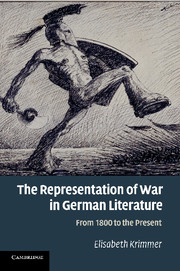Book contents
- Frontmatter
- Contents
- Acknowledgments
- 1 Introduction
- PART I THE REVOLUTIONARY AND NAPOLEONIC WARS
- 2 The Revolutionary and Napoleonic Wars: overview
- 3 War and the sublime: Schiller
- 4 War and terror: Kleist
- PART II THE FIRST WORLD WAR
- PART III THE SECOND WORLD WAR
- PART IV YUGOSLAVIA AND IRAQ
- 14 Conclusion
- Notes
- Bibliography
- Index
2 - The Revolutionary and Napoleonic Wars: overview
Published online by Cambridge University Press: 06 July 2010
- Frontmatter
- Contents
- Acknowledgments
- 1 Introduction
- PART I THE REVOLUTIONARY AND NAPOLEONIC WARS
- 2 The Revolutionary and Napoleonic Wars: overview
- 3 War and the sublime: Schiller
- 4 War and terror: Kleist
- PART II THE FIRST WORLD WAR
- PART III THE SECOND WORLD WAR
- PART IV YUGOSLAVIA AND IRAQ
- 14 Conclusion
- Notes
- Bibliography
- Index
Summary
When we think of German enthusiasm for total war, the eighteenth century does not spring to mind. After all, the Enlightenment is the Age of Reason, whereas war represents the failure of reason. Tellingly, the foremost philosopher of the time, Immanuel Kant (1724–1804), theorized not only man's release from self-inflicted immaturity but also the possibility of eternal peace. And yet, as I will show, First World War authors such as Ernst Jünger are not the first to use war as a springboard to fantasies of transcendence. Side by side with the debate on eternal peace existed another eighteenth-century tradition that considered war a moral institution and lavished praise on its ennobling features. In the following, I will sketch the contours of these positive valuations of warfare and highlight the intimate link between war and the concept of the sublime. In order to explore the nexus between warfare and the sublime, I turn to the works of Kant and Schiller. The following chapter then deals with the somber implications of such a lofty notion of war. In Heinrich von Kleist's Die Hermannsschlacht (1808) and Penthesilea (1807), terror emerges as the dark “Other” of the relation between war and the sublime.
Like all wars, the Revolutionary and Napoleonic Wars of the late eighteenth and early nineteenth centuries are characterized by asymmetries. With their varying coalitions and short-lived peace accords, the wars around 1800 were a patchwork quilt of wide though uneven geographic spread.
- Type
- Chapter
- Information
- The Representation of War in German LiteratureFrom 1800 to the Present, pp. 19 - 26Publisher: Cambridge University PressPrint publication year: 2010
- 1
- Cited by



